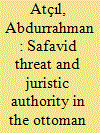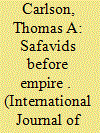|
|
|
Sort Order |
|
|
|
Items / Page
|
|
|
|
|
|
|
| Srl | Item |
| 1 |
ID:
154345


|
|
|
|
|
| Summary/Abstract |
In her writings, the Egyptian-born Israeli author Jacqueline Shohet Kahanoff advocated Levantine cosmopolitanism, which she dubbed Levantinism, as a unique cultural model particular to the Eastern Mediterranean. Through an analysis of Kahanoff's novel Jacob's Ladder (1951), this article questions the nostalgic image often associated with Egyptian cosmopolitanism. I argue that this text provides rare insight into the process through which Levantine culture developed amid several competing imperial and nationalist projects. In particular, I show how the novel's depiction of Levantine spaces documents the marginalized role of the working class in the education of elite Levantine society and its acquisition of cultural capital. My analysis also explores how the construction and sustenance of a celebrated image of the Levantine past depended on the racialization of labor, or what I call “ethnic classism.” Through this latter process, a labor force made up of other cosmopolitan subjects was Orientalized and relegated to the background where it served to highlight a European-like Levantine cosmopolitanism.
|
|
|
|
|
|
|
|
|
|
|
|
|
|
|
|
| 2 |
ID:
154347


|
|
|
|
|
| Summary/Abstract |
This article investigates the opinions of three senior Ottoman jurists, Sarıgörez (d. 1522), Kemalpaşazade (d. 1534), and Ebussuud (d. 1574), on the subject of the Safavids and their supporters. Historians have treated these opinions as part of the vast polemical literature uniformly intended to justify an impending Ottoman attack against their Safavid rivals. Questioning the notion that all authors shared an undifferentiated attitude, this article underlines that, unlike most polemical literature, the opinions of these three jurists focused on the religiolegal aspects of the Safavid issue and varied and evolved in line with changing historical realities, the jurists’ divergent assessments of the Safavid threat, and their preference for different jurisprudential doctrines. Based on an analysis of the opinions, I argue that these jurists assumed a high degree of autonomy as producers and interpreters of the law and thus did not necessarily feel obliged to legitimate or excuse every imperial action.
|
|
|
|
|
|
|
|
|
|
|
|
|
|
|
|
| 3 |
ID:
154346


|
|
|
|
|
| Summary/Abstract |
Armenian sources from the 15th century provide distinctive viewpoints on the history of the Safaviyyih Sufi order before the foundation of the Safavid Empire. The history of T‘ovma of Metsop‘ suggests an earlier intermediate step in the militarization of the order, which scholars have typically viewed as an unprecedented development beginning after 1447, and ascribes to the Safavi shaykh the idea of taxing non-Muslims to encourage conversion to Islam. A second Armenian text, a previously unknown colophon, describes Haydar's attack on Shirvan in 1488 and the suffering of the Muslim and Christian sedentary population, as well as an episode of interreligious mockery. It is probably the earliest extant source to identify the Qizilbash by their distinctive red hats. Together, these sources suggest ways in which the Safaviyyih order's development was conditioned by the multireligious environment. They are examples of the value of non-Muslim sources even for late medieval Islamic history.
|
|
|
|
|
|
|
|
|
|
|
|
|
|
|
|
| 4 |
ID:
154343


|
|
|
|
|
| Summary/Abstract |
The sociosexual world of the premodern Middle East has been studied through a variety of sources ranging from legal documents to shadow theater. Most such sources are either prescriptive or transgressive: they uphold or subvert a normative framework, telling us more about the framework itself than about how it was inhabited by subjects in everyday life. This study introduces the Tıfli stories as a descriptive source that transcends the prescriptive–transgressive dichotomy. An Ottoman-Turkish genre of prose fiction produced at least from the 18th to the 20th century, the Tıfli stories were a protorealist form of “pulp fiction.” Where most sources sought to stabilize specific sociosexual roles, the Tıfli stories explored the ambiguities inherent in these roles. This study employs the Tıfli stories to interrogate understandings of the Ottoman sociosexual world that rely strongly on normative sources and to stage an approximation of how norms were negotiated in practice.
|
|
|
|
|
|
|
|
|
|
|
|
|
|
|
|
| 5 |
ID:
154344


|
|
|
|
|
| Summary/Abstract |
This article examines modernist-nationalist thought on Sufi lodges during the late Ottoman Empire and early Turkish Republic via the controversial novel Nur Baba (1922) by Yakup Kadri Karaosmanoğlu. Widely translated and the basis of the first-ever Turkish motion picture, Nur Baba depicts a debauched Sufi lodge in turn-of-the-century Istanbul where drug use, alcoholism, and illicit amorous liaisons run amok. The novel played an important role in shaping public perceptions of Sufi lodges in the twilight years of the Ottoman Empire. This piece explores the novel's place among early 20th-century critiques of Sufism, its approach to national history, its historical setting (during the reign of Sultan Abdülhamid II), and its close relationship to the intellectual concerns of the Second Constitutional Period (1908–18). It argues for a revised understanding of the novel's historical setting and contends that the novel employs a combination of moralistic critique and romantic nostalgia that is central to modernist-nationalist treatments of Sufism that instrumentalize Sufi culture for nation-building purposes.
|
|
|
|
|
|
|
|
|
|
|
|
|
|
|
|
|
|
|
|
|